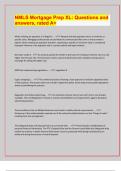1
NR
NR 507 FINAL EXAM QUESTIONS WITH
CORRECT VERIFIED ANSWERS LATEST UPDATE
(2024/2025) GUARANTEED PASS
Accumulation of blood in a subarachnoid haemorrhage - ANS ✓the escape of
blood from a defective or injured vasculature into subarachnoid space (bleeding
into the space between the brain and tissue covering brain). At risk people are
intracranial aneurysm, intracranial arteriovenous malformation, hypertension,
family history of SAH, and those with head injuries. Can reoccur, especially from
a ruptured intracranial aneurysm. Also, heavy alcohol use, tobacco use,
anticoagulation use, and contraceptive use can cause SAH. Mortality is about
50%, one third of survivors require dependent care.
Caused by blood into subarachnoid space and blood increases intracranial
volume, irritates the meningeal and other neural tissues, and causes an
inflammatory reaction. Also blood coats nerve roots, clogs arachnoid
granulations (impairing CSF reabsorption), and clogs foramina within
ventricular system (impairing CSF circulation). Intracranial pressure
increases. Expanding hematoma acts like a space-occupying lesion,
compressing and displacing brain tissue with increased ICP, decreased
cerebral perfusion pressures, decreased cerebral blood flow, blood-brain
barrier breakdown, brain edema, inflammation, and cell death.
S/s severe headache, changes in mental status or level of consciousness,
nausea or vomiting, neuro deficits. Meningeal irritation and inflammation
occur and cause neck stiffness (nuchal rigidity), photophobia, blurred
vision, irritability, restlessness, positive Kernig sign and Brudzinski signs.
Kernig sign- straightening the knee with the hip and knee in a flexed
position produces pain in back and neck regions.
Brudzinski sign- passive flexion of the neck produces neck pain and
increased rigidity
Most common cause of meningitis - ANS ✓an inflammation of the brain or
spinal cord. Can be caused by bacteria, viruses, fungi, parasites, or toxins.
NR 507
, 2
NR
Bacterial- infection of pia mater and arachnoid villi, the subarachnoid
space, ventricular system, and CSF. Affects about 5 to 10 per 100,000 people
annually. Meningococcus and pneumococcus are most common pathogens.
Common in college campuses, military bases, young children or
adolescents. Kissing disease. Most common type
Viral-aseptic meningitis- limited to meninges and an identifiable bacterium
or specific pathogen cannot be found in CSF. Most at risk populations and
times of year are dependent on the virus and immune system of patients.
Fungal- chronic condition and is much less common than bacterial or viral.
Common types: histoplasmosis, cryptococcosis, coccidioidomycosis,
mucormycosis, candidiasis, and aspergillosis.
Tubercular-common and serious form of CNS tuberculosis, common in
immunocompromised patients. Caused by mycobacteria.
Conditions that result in pure water deficit (hypertonic volume depletion) -
ANS ✓a result of pure water losses, hyperventilation, arid climates and an
increase in renal clearance
Osmoreceptors that stimulate thirst and the release of ADH - ANS
✓Increased osmolality stimulates hypothalamic osmoreceptors causing thirst
and signals the posterior pituitary to release ADH
Causes of hypernatremia - ANS ✓Caused by an acute increase sodium level or
loss of water
Hypovolemic hypernatremia: loss of body sodium accompanied by a
relatively greater loss of body water
Causes: loop diuretics, osmotic diuresis, GI losses and kidneys failing to
concentrate urine
Hypervolemic hypernatremia: increase in total body water and greater
increase in total body sodium
Causes: hypertonic saline solutions, over secretion of ACTH, near salt water
drowning
Euvolemic: (most common) loss of free water with near normal total body
sodium
NR 507
, 3
NR
Causes: inadequate water intake, excessive sweating, fever with
hyperventilation and water loss from lungs, burns, nausea/vomiting and
Diabetes Insipidus
Effects of increased aldosterone - ANS ✓Myocardial changes associated with
heart failure, increased sodium and water reabsorption by nephron collecting
duct
Dependent edema - ANS ✓Fluid accumulates in gravity-dependent areas. May
appear in feet and legs when standing and when pressing with fingers a pit will
remain after you remove your fingers.
Definition of isotonic - ANS ✓Solution or fluid having same osmotic pressure as
the other solution or fluid
Principle of capillary oncotic pressure - ANS ✓Form of osmotic pressure.
Chemical force exerted by large molecules (ex. Proteins/albumins) to pull
fluid in
Types of fluid compartments in the body - ANS ✓Intracellular fluid (ICF): fluid
within cells. 40% of body weight
Extracellular Fluid (ECF): Fluid outside cells. 20% of body weight.
Intravascular (IV); blood plasma (< 5%)
Interstitial (IF): Fluid between cells and outside blood vessels (< 15%)
Other Fluids: lymph, synovial, CSF, intestinal, sweat, urine, intraocular and
body cavity fluids.
Two traffic patterns
1) Between ICF and ECF: by osmosis movement of water and small particles
across a membrane as determined by solute concentration.
NR 507
, 4
NR
Normal fluid movement favours isotonic conditions(ICF and ECF osmolality
os equal) balanced movement=isovolemia
Hypotonic= ECF has lower osmolality than ICF, draws water into cells
Hypertonic: ECF has a higher osmolality then ICF, draws water out of the
cell
2)Between IV and IF: IV to IF movement= filtration
IF to IV movement= reabsorption
Physiological response to hypoxia in anemia - ANS ✓Activation of RAA
system
Interstitial fluid moves into capillaries
Blood flows faster
Hyperdynamic state leading to tachycardia and HF
Erythropoiesis is stimulated to produce more RBC
Populations at the highest risk for developing folate deficiency anemia -
ANS ✓Folate is absorbed directly from GI tract
Caused by malnutrition, alcoholism, anticonvulsant Rx
Causes of iron deficiency anemia - ANS ✓insufficient Fe availability
Caused by inadequate dietary intake, chronic or occult bleeding, decrease
ability to use Fe for heme synthesis.
Ulcers, menstrual bleeding, left colon cancer, elderly and poor children,
malabsorption, gastrectomy, hookworm, Plummer-Vinson
Expected lab test results found in long standing iron deficiency anemia -
ANS ✓Hemoglobin level decreased to 7-8g/dl
Sickle Cell Anemia (SCA) - ANS ✓inherited autosomal recessive genetic
disorder
From 2 abnormal genes
NR 507





